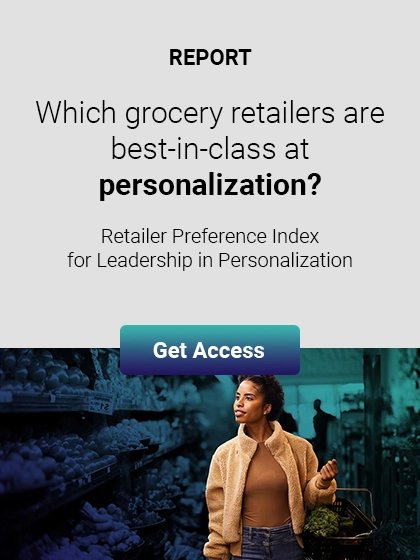Healthy diets and unhealthy price perceptions
Price and value for money are top of mind for many customers, driven by a long list of factors, such as Covid, inflation, war, climate change and threats of recession. And all these factors are impacting the cost of living across multiple sectors.
Despite these obstacles, healthy eating is a perennial aim for many customers. For example, according to dunnhumby’s UK health tracker research (data from February 2022), customers told us:
- 72% say that “eating healthily makes me feel good”
- 68% say that “I would like to lead a healthier lifestyle”
- 65% say that “diet and nutrition information on packaging is helpful”
This blog suggests a healthy diet costs more than an unhealthy diet. This implies those retailers who focus on customer health may negatively impact their price perception. However, there may be ways to combine being a healthy retailer with positive price perception.
Healthier diets may cost more
Nutritionally healthy diets do indeed appear to cost more than nutritionally unhealthy ones. According to a UK study in 2014, the healthiest diet cost over double that of the unhealthiest diet at £6.63 and £3.29 per day respectively1. According to a more recent 2021 UK report2, the cost of more healthy food is three times as expensive as less healthy food (£7.00 vs £2.41 respectively).
Furthermore, there is some evidence that promotions are more effective for unhealthy impulse products. In a longitudinal study of Scottish households, the consumption levels of categories such as biscuits, crisps and savoury snacks were influenced by volume promotions3.
A 2019 global Lancet study found the median cost of a healthy diet based on 2011 prices was $2.84 per day4. The affordability of such a diet as a proportion of mean daily household income per capita, was 6.1% in high income countries but 89.9% in low-income countries. They also concluded that 1.58bn people are unable to afford such a diet, most of whom are located in sub-Saharan Africa and south Asia.
Given healthier diets may cost more, this may imply a retailer who has a greater focus on healthy products and healthy ranges may be perceived as more expensive. Given price is top of mind for many customers right now, how can retailers provide a health focus without negatively impacting price perception?
How to balance good prices and good health?
There are a number of possible ways to help balance health and good prices at the same time:
- Do the research to find out what customers perceive to be healthy foods. This may differ from nutritionally healthy foods and may highlight educational needs.
- Highlight private brands that are as nutritious as national brands
- Review Known Value Items (KVIs) which have high associations with good health5. This could be in the form of price matches or guarantees.
- Citing private brands and KVIs, communicate that good health does not need to cost more6.
- Assuming there are no additional costs when online, it may be possible to recommend a healthy alternative to an unhealthy product. In an online simulation, 28% of customers chose the healthier suggestion7.
- Increase investments in seasonal and local produce, these may help aid the perception that they are well priced.
- Given nudge theory does not utilise prices, it may be a useful method to encourage healthy purchases (see previous blog on health nudges). Apply indulgent descriptions to healthy foods (see previous sustainability blog). Narrowing the gap in how healthy foods are described may also narrow the gap in price perceptions.
- Healthy foods may also have an association with other variables: sustainability, fair trade, the presence or absence of ingredients, local brands. Aligning with these areas may also support the uptake of healthy products.
- Be aware that other counters or stores within the building (e.g., pharmacy) may influence the perception of health of the store.
- Lastly, there may be a quirkier, and more unusual option too. More than two-minutes of exposure to an unhealthy smell (e.g., a cookie smell) was found to decrease unhealthy purchases8. The study suggests that one sense can affect another (smell can satiate your desire to eat unhealthily). Could this finding be extended to price perception? Could an unhealthy food smell maybe even prime better prices?
With governments waning on applying fiscal policy to make healthier foods more affordable for all, the duty of care is increasingly falling on retailers to help their customers. And, as we’ve discussed, this will inevitably cause some challenges with shopper perception, with healthier retailers having a higher price perception.
But, by using a combination of the strategies above, retailers can help to address this challenge, and continue to offer their customers healthier options without the store, or these options, becoming seen as a premium offering.
References
1 Morris, M.A., Hulme, C., Clarke, G.P., Edwards, K.L. and Cade, J.E. (2014). What is the cost of a healthy diet? Using diet data from the UK Women’s Cohort Study. Journal of Epidemiology and Community Health 68 (11): 1043-1049
3 Kopasker, D., Ejebu O-Z, Norwood, P., et al (2022). Longitudinal study of the effects of price and promotion incentives on purchases of unhealthy foods: evidence for restricting food promotions. BMJ Nutrition, Prevention & Health: 0:e000323. doi:10.1136/ bmjnph-2021-000323
4 Hirvonen, K., Bai, Y., Headey, D., & Masters, W.A. (2020). Affordability of the EAT–lancet reference diet: A global analysis. The Lancet Global Health, 8(1), e59–e66.
7 Bunten A., Porter L., Sanders J.G., Sallis A., Payne Riches, S., Van Schaik, P., et al. (2021). A randomised experiment of health, cost and social norm message frames to encourage acceptance of swaps in a simulation online supermarket. PLoS ONE 16(2): e0246455. https://doi.org/10.1371/journal.pone.0246455
8 Biswas, D. and Szocs, C. (2019). The Smell of Healthy Choices: Cross-Modal Sensory Compensation Effects of Ambient Scent on Food Purchases. Journal of Marketing Research 56(1): 123-141
TOPICS
RELATED PRODUCTS
A look at dunnhumby’s unique Customer Data Science, which is at the core of everything we do.
Data Science solutionsThe latest insights from our experts around the world
AI's Regulatory Crossroads: Innovation vs. Control
Why you need a demand model
AI: three breakout applications for consumer brands

Speak to a member of our team for more information



